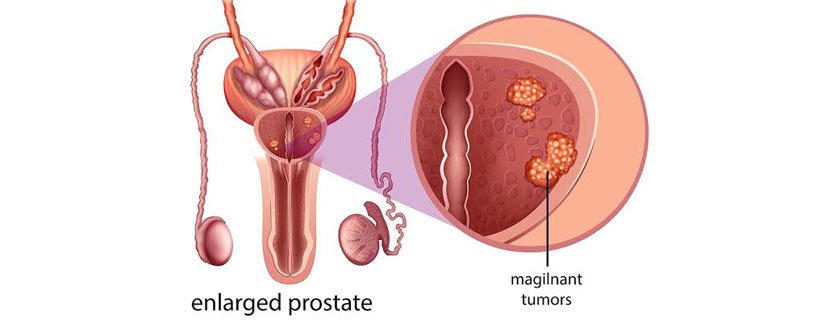Book Appoinment
Prostate Cancer


Prostate cancer is a type of cancer that occurs in the prostate gland, a small walnut-shaped gland in males that produces seminal fluid. It is one of the most common types of cancer in men, particularly in older individuals. Prostate cancer typically grows slowly and may not cause symptoms in the early stages. However, it can be aggressive and spread to other parts of the body if not detected and treated early.
Causes:
The exact cause of prostate cancer is unknown. However, several risk factors have been identified that may increase the chances of developing the disease:
- Age: Prostate cancer is more common in older men, particularly those over the age of 50. The risk increases significantly with age.
- Family history: Having a family history of prostate cancer, especially in a father or brother, increases the risk. Certain inherited gene mutations, such as BRCA1 and BRCA2, are also associated with a higher risk of prostate cancer.
- Ethnicity: Prostate cancer is more common in African-American men compared to men of other ethnic backgrounds. It is less common in Asian and Hispanic men.
- Diet: A diet high in red meat and high-fat dairy products and low in fruits and vegetables may increase the risk of prostate cancer. However, more research is needed to establish a definitive link.
- Obesity: Obesity has been linked to a higher risk of aggressive prostate cancer and a poorer prognosis.
Symptoms:
In the early stages, prostate cancer may not cause noticeable symptoms. As the disease progresses, the following signs and symptoms may occur:
- Urinary symptoms: Increased frequency of urination, especially at night (nocturia), weak urine flow, difficulty starting or stopping urination, or a sense of incomplete emptying of the bladder.
- Blood in urine or semen: Blood may be visible in the urine or semen, leading to discoloration.
- Erectile dysfunction: Difficulty achieving or maintaining an erection may occur in some cases.
- Pain or discomfort: Painful urination, pelvic pain, or discomfort in the lower back, hips, or thighs may be experienced.
Diagnosis and Treatment:
Prostate cancer is typically diagnosed through a combination of medical history evaluation, physical examination, blood tests (such as prostate-specific antigen or PSA test), and imaging studies (such as ultrasound, MRI, or biopsy).
Treatment options for prostate cancer depend on various factors, including the stage and aggressiveness of the cancer, overall health, and individual preferences. Treatment options may include:
- Active surveillance: For slow-growing, low-risk prostate cancer, active surveillance may be recommended. Regular monitoring is conducted to assess the progression of the disease, and treatment may be initiated if necessary.
- Surgery: Radical prostatectomy involves surgically removing the entire prostate gland and some surrounding tissues. It can be done through open surgery or minimally invasive techniques such as laparoscopic or robotic-assisted surgery.
- Radiation therapy: High-energy radiation is used to kill cancer cells or inhibit their growth. It can be delivered externally (external beam radiation therapy) or internally using radioactive seeds (brachytherapy).
- Hormone therapy: Prostate cancer cells are stimulated by male hormones (androgens) like testosterone. Hormone therapy aims to reduce the levels of these hormones or block their effects, slowing down the growth of cancer cells.
- Chemotherapy: Chemotherapy uses drugs to kill cancer cells or stop their growth. It is typically used in advanced or metastatic prostate cancer when
